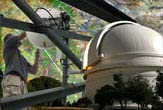
| 2006-08-23 10:06:23 |
Wireless Network Helps Unlock Secrets of the Universe, Space.com

By Ker Than
LiveScience Staff Writer
In the days of astronomers like Edwin Hubble and Alan Sandage, before computers were widespread, using observatory
telescopes to study the cosmos was grueling work.
Astronomers had to climb atop platforms on the sides of the giant instruments and constantly monitor the night sky
to keep in focus those stars whose light were being slowly collected onto photographic plates.
"They would be up there for hours, in the cold and dark by themselves," said Scott Kardel, a spokesman for the Palomar
Observatory in Southern California.
A telescope's speed had to be continually adjusted by tapping buttons on a control paddle, and on the morning after a
cold night, an astronomer might find that his tears had frozen him to the eyepiece.
But those days are long gone. Automated telescopes are now doing work once done by tortured astronomers, and thanks to
a new high speed wireless microwave network, today's digitally captured images can be beamed down from mountain
observatories and quickly distributed to astronomers living thousands of miles away.
Called the High Performance Wireless Research and Education Network, or HPWREN for short, it can transfer data at 45
megabits-per-second, or about 30 times faster than today's fastest DSL connections. One megabit is equal to 1 million
bits.
A key instrument
Future upgrades are expected to make the network even faster, said Hans-Werner Braun, the HPWREN principal investigator
and a research scientist at the San Diego Computer Center at the University of California, San Diego.
"The current plan is to upgrade critical links that support the [Palomar] observatory to 155 Mbps and create a redundant
45 Mbps path for a combined 200 megabits-per-second access speed at the observatory," Braun said.
Last summer, HPWREN helped astronomers using a Palomar telescope to discover a rocky object located on the outer fringes
of our solar system beyond Pluto.
Kardel says the 48-inch Samuel Oschin Telescope used to spot the new world was still using glass photographic plates
to capture images as recently as 2000.
After exposure, "a plate had to be taken down to a darkroom, developed and then scanned before it was written to some
form of medium and hand-carried to someone doing research in a lab," Kardel told SPACE.com.
Today, the Samuel Oschin Telescope uses a 161 mega-pixel digital camera to observe the cosmos and the data is beamed
wirelessly down the mountain using HPWREN.
By allowing astronomers quick access to collected data, the wireless network is also proving instrumental in the hunt
for extrasolar planets, as well as in the study of Type 1a supernovas, exploding stars that serve as "standard candles"
for measuring the expansion of the universe.
Other uses
Telescopes at Palomar can use up to 200 million bytes of storage space a night, Braun said.
After images are beamed down from the mountain observatories, they are distributed to astronomers at different
universities and research institutions using "Internet2," a high speed data network many times faster than typical home
internet connections.
Today, an astronomer at Yale in Connecticut can download a 100 megabyte image taken by an automated telescope in California
in less than 30 seconds.
Operational since 2001, HPWREN is also changing how scientists do research in fields besides astronomy. Seismologists are
using the network to gather data from remote survey stations and wildlife researchers are using it to observe how wolves
behave in the wild using wireless cameras.
The California Department of Forestry is also using gear that taps into HPWREN to set up local command posts during forest
fires.
But the field most affected by the technology might be astronomy. Gone are the days when astronomers had to lock
themselves up in mountain observatories and chain themselves to telescopes for entire nights.
"Astronomers can have a life, sleep and be with their families," Kardel said. "It's allowed us to make much more
efficient use of telescope time. There's no more wasting of hours and hours on something that might not go right."
